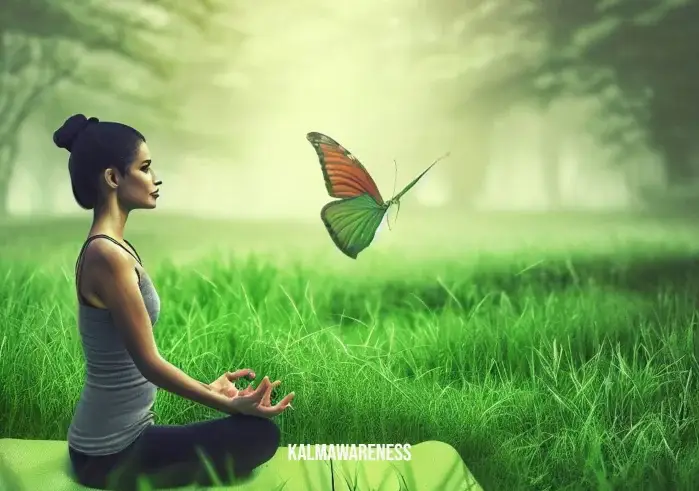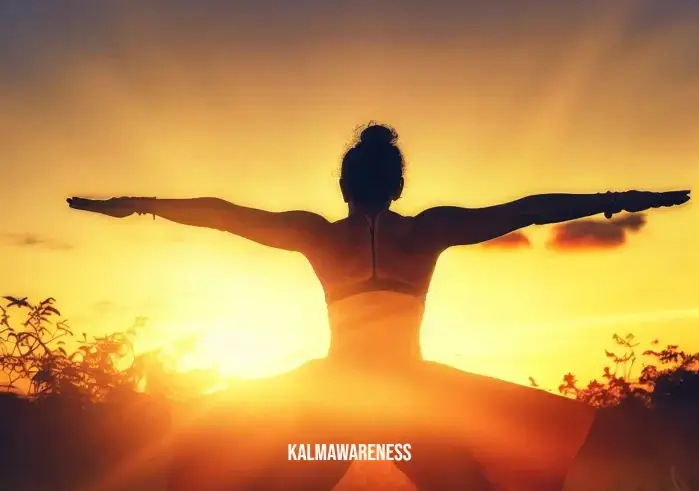Embracing Serenity and Flexibility
Yoga Butterfly Pose Original Name | Baddha Konasana Difficulty Level | Intermediate Pose Category | Seated Poses Exercise Duration | 5-10 minutes
Welcome to the world of yoga, where tranquility and physicality intertwine harmoniously. In this article, we will explore the captivating Yoga Butterfly Pose, also known as Baddha Konasana. With its roots in ancient yogic traditions, this pose embodies a beautiful blend of serenity and flexibility. So, let’s dive into the gentle and transformative journey of the Yoga Butterfly Pose.
Embracing Stillness and Connection
The Yoga Butterfly Pose is a seated asana that primarily targets the hips, inner thighs, and groins. As you assume this pose, you will experience a gentle opening and release in these areas, promoting flexibility and relaxation. Let’s take a closer look at how to perform this graceful pose step by step:
- Find a quiet and comfortable space. Sit on a yoga mat or a cushion with your back straight and your legs extended in front of you.
- Bend your knees and bring the soles of your feet together, allowing your knees to naturally fall to the sides. Your feet should be close to your pelvis, creating a diamond shape with your legs.
- Place your hands on your feet or ankles, ensuring a gentle grip. Inhale deeply, elongating your spine and lifting your chest.
- Exhale slowly as you gently press your thighs toward the floor. Maintain a relaxed and steady posture.
- If it feels comfortable, you can use your hands to gently press down on your thighs, enhancing the stretch in your hips and groins. Remember to listen to your body and only go as far as it feels comfortable for you.
- Stay in this position for 5 to 10 minutes, breathing deeply and allowing your body to surrender into the pose. Embrace the sensations and find a sense of calmness and connection within.
The Essence of Balance and Flexibility
Yoga Butterfly Pose offers a multitude of benefits for both beginners and advanced practitioners. Let’s explore the duration for holding this pose and its advantages:
- For Beginners: If you’re new to this pose, start by holding it for 5 minutes. Gradually increase the duration as your body becomes more accustomed to the stretch and your flexibility improves.
- For Advanced Practitioners: Advanced practitioners can aim to hold the pose for up to 10 minutes. As you deepen your practice, you will notice increased flexibility and a greater sense of calmness and focus.

Unlocking the Benefits and Variations of Yoga Butterfly Pose
Welcome back to our exploration of the transformative Yoga Butterfly Pose! In this chapter, we will delve into the incredible benefits this pose offers, discuss who should approach it with caution, and explore variations to accommodate practitioners of different experience levels. Let’s continue our journey of serenity and flexibility.
Embracing the Benefits
Yoga Butterfly Pose brings a multitude of physical, mental, and energetic benefits to those who practice it regularly. Let’s explore some of these benefits:
- Hip Opening: The primary focus of this pose is to open and stretch the hips. As you gently press your thighs toward the floor, you release tension and tightness in the hip joints, improving flexibility and promoting ease of movement.
- Flexibility Enhancement: Regular practice of Yoga Butterfly Pose gradually increases the range of motion in your hips, groins, and inner thighs. This improved flexibility not only supports your yoga practice but also enhances overall physical performance and reduces the risk of injuries in daily activities.
- Stimulates Digestion: By stimulating the abdominal organs, including the bladder and kidneys, this pose helps improve digestion and alleviate discomfort associated with indigestion. It can also aid in relieving menstrual discomfort.
- Relaxation and Calm: The gentle and meditative nature of the pose promotes relaxation and calmness. As you hold the pose, focus on deep, mindful breathing, allowing stress and tension to melt away. This relaxation response can be particularly beneficial for those dealing with anxiety, stress, or insomnia.
- Energetic Alignment: Yoga Butterfly Pose helps align and balance the energy flow in the body, particularly in the sacral chakra. This alignment supports creativity, emotional balance, and a sense of overall well-being.
Cautionary Considerations
While Yoga Butterfly Pose offers numerous benefits, there are certain individuals who should approach it with caution or avoid it altogether. It’s important to listen to your body and consult with a qualified yoga teacher or healthcare professional if you have any concerns. Here are some considerations:
- Knee or Groin Injuries: If you have a knee or groin injury, it’s crucial to approach this pose with caution. Modify the pose by placing a bolster or folded blanket under your knees for support and only go as far as it feels comfortable for you.
- Lower Back Issues: Individuals with lower back issues, such as herniated discs or sciatica, should approach this pose mindfully. Support your back with a cushion or folded blanket and avoid rounding your spine excessively.
- Pregnancy: Pregnant women should modify or avoid Yoga Butterfly Pose, especially during the later stages of pregnancy. Consult with a prenatal yoga instructor for suitable modifications and alternatives.
- Recent Surgery or Injury: If you’ve recently undergone surgery or have any acute injuries, it’s advisable to avoid this pose until you have fully recovered and received clearance from your healthcare professional.
Always prioritize your safety and well-being when practicing yoga. If in doubt, seek guidance from a qualified instructor.
Variations for Every Experience Level
Yoga Butterfly Pose can be modified and adjusted to accommodate practitioners of different experience levels. Here are a few variations you can explore:
- Supported Butterfly Pose: For beginners or individuals with limited flexibility, use props such as blocks or bolsters under your knees to support them in the pose. This variation reduces strain on the hips and allows you to ease into the stretch gradually.
- Extended Butterfly Pose: As you become more comfortable with the basic pose, you can extend your legs straight in front of you while maintaining the diamond shape with your feet. This variation intensifies the stretch in the hips and groins.
- Baddha Konasana Twist: To add a gentle twist to the pose, place your left hand on your right knee and your right hand behind you. Inhale to lengthen your spine, and as you exhale, gently twist to the right. Hold for a few breaths, then repeat on the other side. This variation further enhances spinal mobility and releases tension in the back.
Remember to approach these variations with mindfulness and respect for your body’s limitations. Gradually explore and progress as your practice evolves.
Continuing Our Journey
In the next part of our article, we will explore how Yoga Butterfly Pose can be integrated into a comprehensive yoga sequence or practice. We will dive into the sequencing principles, complementary poses, and explore ways to enhance your overall yoga experience.
Join us in Part 3 as we continue to unlock the potential of Yoga Butterfly Pose and its harmonious integration within a broader yoga practice. Get ready to deepen your connection with yourself and the transformative power of yoga.

Unveiling the History, Spirituality, and Enhancements of Yoga Butterfly Pose
Welcome back to our enchanting journey through the realms of Yoga Butterfly Pose! In this chapter, we will explore the rich history behind the pose, delve into its spiritual significance, discover valuable tips for maximizing its benefits, identify common mistakes to avoid, explore modifications for individuals with injuries or limited flexibility, and uncover complementary poses. Let’s continue our exploration and deepen our understanding of this transformative pose.
Unearthing the Historical Roots
Yoga Butterfly Pose, with its graceful form and meditative qualities, traces its origins back to ancient yogic traditions. While the exact origin of the pose remains a mystery, it has been practiced for centuries as a means of connecting mind, body, and spirit. As we settle into the pose, let us honor the countless yogis who have embraced its wisdom and grace throughout history.
The Spiritual Significance
Beyond its physical benefits, Yoga Butterfly Pose carries spiritual significance. It symbolizes the fluttering wings of a butterfly, representing transformation, freedom, and spiritual growth. By assuming this pose, we embody the essence of these qualities and invite their energy to flow within us. It serves as a gentle reminder of our ability to transform, evolve, and embrace the beauty of our own spiritual journey.
Tips for Deepening Your Practice
To extract the most profound benefits from Yoga Butterfly Pose, consider the following tips:
- Focus on Breath: Throughout the pose, prioritize deep, mindful breathing. Inhale fully, expanding your belly, and exhale slowly, releasing any tension or resistance. Allow your breath to guide you deeper into the pose, creating a sense of internal spaciousness.
- Maintain Gentle Alignment: While in the pose, keep your spine lengthened and your shoulders relaxed. Avoid rounding your back or forcing your knees closer to the ground. Remember, the goal is not to reach a specific depth but to find a comfortable position that respects your body’s limits.
- Explore Micro-Movements: Engage in subtle, gentle movements within the pose. Sway gently from side to side or rock forward and backward, allowing your body to find its own rhythm and release any stagnant energy.
- Cultivate Mindfulness: Embrace a state of present-moment awareness as you practice Yoga Butterfly Pose. Allow your thoughts to dissolve and immerse yourself fully in the sensations of your body. Connect with the serenity and stillness that reside within you.
Common Mistakes to Avoid
To ensure a safe and effective practice, be mindful of these common mistakes:
- Forcing the Knees: Avoid excessive force or pushing your knees toward the ground. Respect your body’s natural range of motion and work within its limitations. Overstretching can lead to strain or injury.
- Rounding the Spine: Maintain an elongated spine throughout the pose. Avoid hunching or rounding your back, as this can compromise alignment and reduce the benefits of the stretch.
- Neglecting the Breath: Remember to prioritize deep, conscious breathing. Avoid shallow or irregular breaths, as they hinder the relaxation response and the flow of energy within the pose.
Modifications for Adaptability
Yoga Butterfly Pose can be modified to accommodate individuals with injuries or limited flexibility. Consider the following variations:
- Use Props: Place a bolster, blanket, or cushion under your hips for extra support and elevation. This modification helps alleviate strain on the hips, knees, or lower back.
- Wall Support: If you experience difficulty in sitting upright, position yourself against a wall for added support. Lean your back against the wall to maintain an aligned posture throughout the pose.
- Seated Version: For individuals with limited mobility, perform a seated version of the pose on a chair. Keep your feet flat on the floor and focus on the gentle opening in the hips and groins.
Complementary Poses
To enhance the benefits of Yoga Butterfly Pose and create a well-rounded practice, consider incorporating these complementary poses:
- Seated Forward Bend (Paschimottanasana): This pose stretches the entire back body, including the hamstrings and calves. It complements Yoga Butterfly Pose by further opening the hips and facilitating a deeper forward fold.
- Wide-Legged Forward Bend (Prasarita Padottanasana): This pose offers a deep stretch to the inner thighs and groins. It cultivates flexibility and strengthens the legs, serving as an ideal counterpart to the hip-opening nature of Yoga Butterfly Pose.
- Reclining Bound Angle Pose (Supta Baddha Konasana): This restorative pose allows for a gentle and supported release in the hips and groins. It promotes relaxation, making it an excellent complement to the meditative qualities of Yoga Butterfly Pose.




